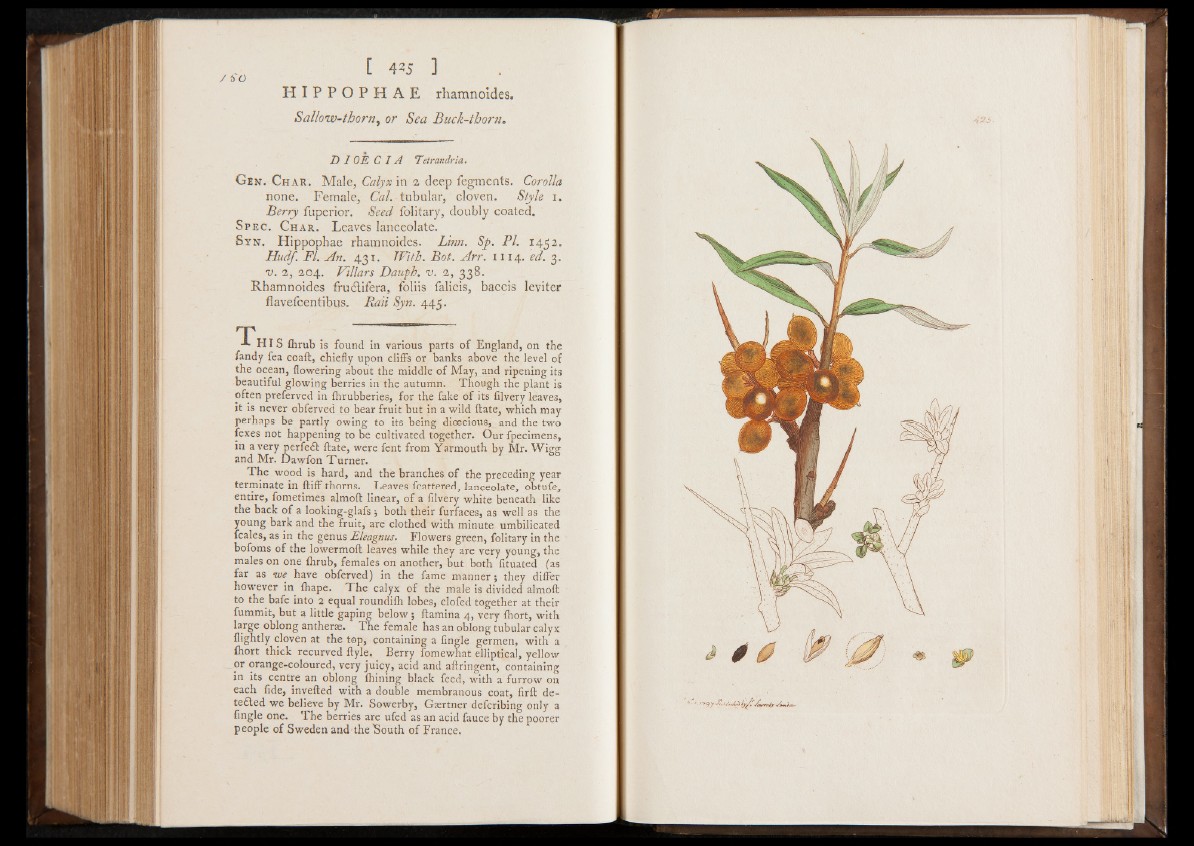
H I P P O P H A E rhamnoides.
Sallow-thorn, or Sea Buck-thorn.
D IOE C I A Tetrandria.
Gen. Char. Male, Calyx in 2 deep fegments. Corolla
none. Female, Cal. tubular, cloven. Style i.
Berry fuperior. Seed folitary, doubly coated.
Spec. Char. Leaves lanceolate.
Syn. Hippophae rhamnoides. Linn. Sj>. PI. 1 4 5 2 .
Hudf. FI. An. 431. With. Bot. Arr. 1 114. ed. 3.
v. 2, 204. Fillars Dauph, v. 2, 338.
Rhamnoides frubtifera, foliis falicis, baccis leviter
flavefcentibus, Rail Syn. 443.
-*■ H IS flirub is found in various parts of England, on the
fandy fea coaft, chiefly upon cliffs or banks above the level of
the ocean, flowering about the middle of May, and ripening its
beautiful glowing berries in the autumn. Though the plant is
often preferved in fhrubberies, for the fake of its filvery leaves,
it is never obferved to bear fruit but in a wild ftate, which may
perhaps be partly owing to its being dioecious, and the two
fexes not happening to be cultivated together. Our fpecimens,
in a very perfect ftate, were fent from Yarmouth by Mr. Wigg
and Mr. Dawfon Turner.
The wood is hard, and the branches of the preceding year
terminate in ftifF thorns. Leaves fcattered, lanceolate, obtufe,
entire, fometimes almoft linear, of a filvery white beneath like
the back of a looking-glafs both their furfaces, as well as the
young bark and the fruit, are clothed with minute umbilicated
fcales, as in the genus Eleagnus. Flowers green, folitary in the
bofoms of the lowermoft leaves while they are very young, the
males on one fhrub, females on another, but both fituated fas
far as we have obferved) in the fame manner; they differ
however in fhape. The calyx of the male is divided almoft
to the bafe into 2 equal roundith lobes, clofed together at their
fummit, but a little gaping below; ftamina 4, very fhort, with
large oblong anther*. The female has an oblong tubular calyx
flightly cloven at the top, containing a fingle germen, with a
fhort thick recurved ftyle, Berry fomewhat elliptical, yellow
or orange-coloured, very juicy, acid and aftringent, containing
in its centre an oblong fhining black feed, with a furrow on
each fide, invefted with a double membranous coat, firft detected
we believe by Mr. Sowerby, Gaertner defcribing only a
fingle one. The berries are ufed as an acid fauce by the poorer
people of Sweden and the South of France.